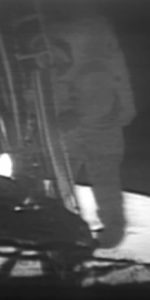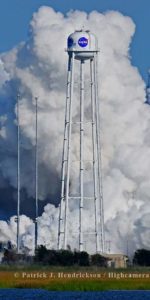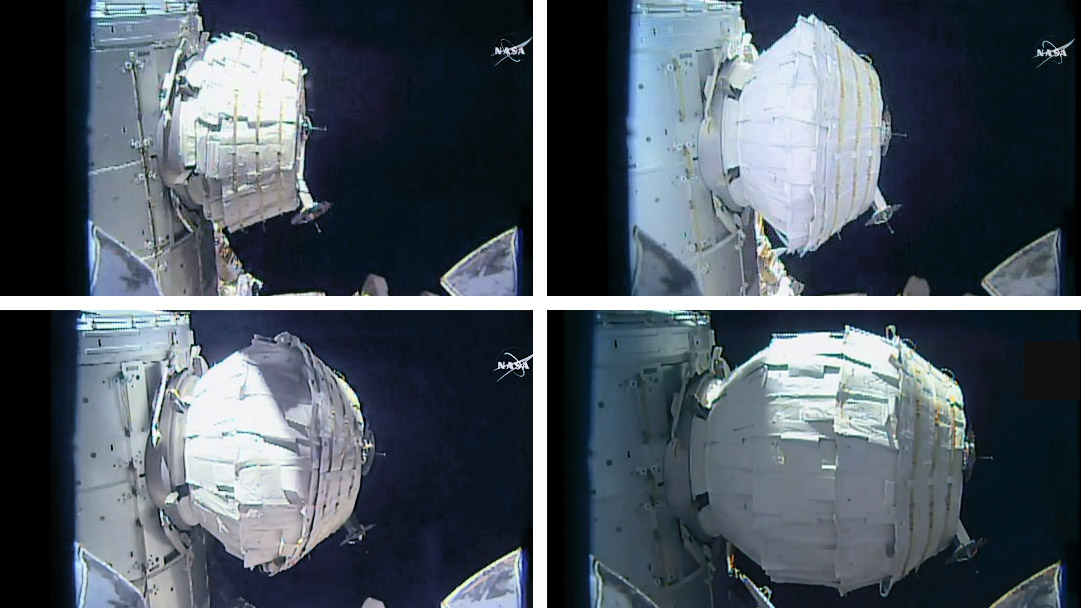
This weekend’s successful expansion of the Bigelow Expandable Activity Module (BEAM) on the International Space Station (ISS) represented a major milestone as NASA and private industry seek to validate pressurized expandable habitats for future space exploration. As a team in the Mission Control Center (MCC) at the Johnson Space Center (JSC) watched, monitored, and planned, Expedition 47 astronaut Jeff Williams admitted small quantities of air into the new module to gradually transition from its “packed” configuration into its “Full Shape.” Over the next few days, BEAM will be comprehensively leak-checked by controllers on the ground, with an expectation that the first ingress of the module—by Williams and also a member of the Russian Orbital Segment (ROS) crew—will take place around Monday, 6 June.
As outlined previously by AmericaSpace, BEAM arrived on-station aboard SpaceX’s CRS-8 Dragon—the eighth dedicated cargo delivery mission under the language of its initial $1.6 billion Commercial Resupply Services agreement with NASA—on 10 April. It was later transferred, via the 57.7-foot-long (17.6-meter) Canadarm2 robotic arm, from Dragon’s unpressurized trunk to its final location on the aft-facing Common Berthing Mechanism (CBM) of the Tranquility node on 15 April. Since then, the module has remained in its unpressurized, “packed” configuration, measuring about 5.7 feet (1.7 meters) long and 7.7 feet (2.4 meters) in diameter.
During this period, the Expedition 47 crew—consisting of Commander Tim Kopra of NASA, as well as Russian cosmonauts Yuri Malenchenko, Alexei Ovchinin, and Oleg Skripochka, together with U.S. astronaut Jeff Williams and Britain’s Tim Peake—oversaw the outfitting of the vestibule between the Tranquility aft CBM and the station itself. This included a comprehensive series of systems and leak checks, ahead of the actual five-part expansion process, led by Williams, on 26 May.
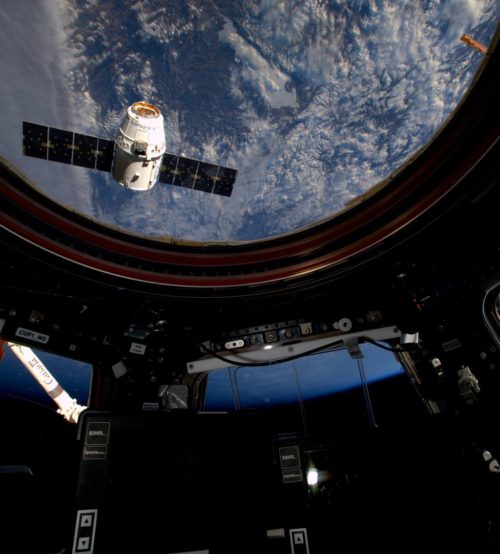
Earlier this week, it became clear that Jessica Meir, a member of NASA’s 2013 astronaut class, would serve as Capcom for the BEAM expansion activity. “Excited to serve as CAPCOM for #BEAM this week,” she tweeted on Monday. Seated alongside her in the Mission Control Center (MCC) at the Johnson Space Center (JSC) in Houston, Texas, was Flight Director Brian Smith, who joined the ranks of NASA’s flight director corps in April 2015. Aboard the ISS, activities have entered high gear in recent days to get BEAM ready to expand from its packed configuration into its torus-like deployed configuration, which were expected to see it measure 13 feet (4 meters) long and 10.5 feet (3.2 meters) in diameter. On Tuesday, the crew removed the Aft Hatch Positive Pressure Relief Valve (PPRV) Sample Port Cap from Tranquility, then pressurized the connecting vestibule to 5 psi. This was followed by a lengthy leak check, lasting about eight hours. Williams also set up and activated the BEAM Deployment Controller panel, which he would use to command and monitor the expansion activity. Additionally, the crew reviewed updated emergency procedures and other key points emphasized during their BEAM training.
As highlighted previously by NASA, a core requirement of the expansion is having near-continuous orbital daylight and, through the Tracking and Data Relay Satellite System (TDRSS), continuous video communication. At present, the ISS is in a so-called “High-Beta-Angle” orientation, which has the effect of placing it near-constant sunlight for several orbits. This was expected to aid the ground teams in monitoring BEAM’s expansion. “This morning we started several days of something unique—no sunsets,” Williams tweeted. “From our point of view, the sun circles us.”
Early Thursday, images revealed the pressurized vestibule and showed Tranquility’s aft hatch to be open, together with the closed BEAM hatch behind it. In a recent interview, Expansion Lead Heide Brewer explained that bringing BEAM—the first pressurized habitable module to arrive at the ISS since the Leonardo Permanent Multipurpose Module (PMM), back in February 2011—from its packed configuration to “Full Shape” required five detailed steps by Williams. The first step was to close the Ascent Vent Valve (AVV), which had been left open since BEAM’s arrival, in order to maintain its depressurized state and keep it at vacuum. This was then followed by the cutting of three Restraint Straps from around the circumference of BEAM. The cutting was executed by three pyrotechnic devices, known as NASA Standard Initiators (NSIs), and the process was commanded by Williams, stationed at the BEAM Deployment Controller panel inside Tranquility.
Despite some initial difficulties with the firing of the pyros—which produced a glowing “Fault” light on the controller panel at one point—all three straps were confirmed as having been successfully cut at 5:55 a.m. EDT Thursday. Next came the release of BEAM’s forward bulkhead, in which four internal support struts were deployed, via four bolts per strut. Shortly thereafter, Meir radioed Williams a “Go” to progress into the “Manual Expansion” phase of the operation, to which the seasoned veteran astronaut responded: “ISS crew is ready for BEAM inflation.”
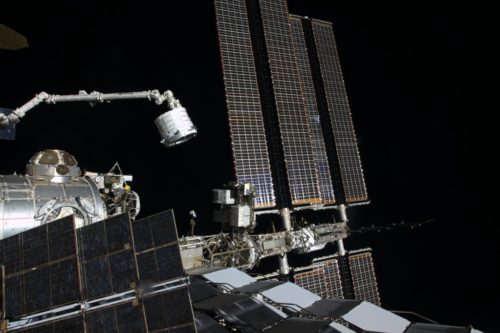
Thus began an effort which was anticipated to require around 45 minutes to complete. It called for Williams to manually introduce short “bursts” of air, in a series of incremental steps, using eight tanks located inside BEAM. In each case, the astronaut opened the valve, entered air for a specified number of seconds, closed the valve and relayed pressure data readings back to Mission Control. This was then inputted into a Pressure Curve Plot by the Robotics Officer (ROBO) and the Environmental and Thermal Operating Systems (ETHOS) Officer, who determined the duration of the next introduction of air. These timings were relayed to Meir, who, in turn, passed them up to Williams.
By 6:20 a.m., Meir radioed that controllers had “seen some expansion of BEAM and are assessing right now.” In its first burst of airflow, it expanded outward by about an inch (2.5 cm). And, indeed, the imagery over the following minutes showed it steadily beginning to “bulk-out,” although it remained unknown exactly what final shape the module would take. It was noted that a relatively low pressure—barely 0.4 psi—was necessary to achieve and hold BEAM’s shape, although by the point it reached Full Shape it would have expanded in volume from 127 cubic feet (3.6 cubic meters) to 565 cubic feet (16 cubic meters).
However, it was determined that they were slightly “high” on the Pressure Curve and a temporary hold was called to allow the situation to settle down. The key concern centered on understanding how much BEAM was expanding along both its length and diameter. Finally, at 6:51 a.m., Meir radioed Williams with an instruction to introduce air for a duration of one additional second. “And a generous one second!” she added, with the barest hint of humor in her tone. As controllers continued to work on stabilizing the position on the Pressure Curve, the station passed out of direct communications range and efforts entered a “Holding Pattern,” pending the reacquisition of live TDRSS video coverage.
During this quiet period, Williams was pressed by Meir with regard to an earlier observation about hearing a strange noise inside BEAM. He described it as “a fairly distinct single bang,” but admitted that he could not describe it in any more detail. It was quickly verified that the sound came from four shear-pins, which were due to detach inside the module at the same time. As expected, good video communications were restored at 7:25 a.m. EDT, but Williams was told to focus on other tasks as discussions over the Pressure Curve issue continued within the Mission Evaluation Room (MER) at Mission Control.
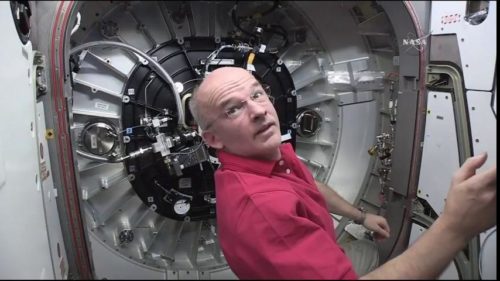
Finally, at 7:50 a.m., Meir called Commander Tim Kopra. She advised him that efforts to resume BEAM expansion were almost ready and asked if he was prepared to defer the crew’s pre-planned exercise session using the Cycle Ergometer with Vibration Isolation and Stabilization System (CEVIS). Kopra confirmed that he was happy to delay the exercise session and, after confirming with Russian flight controllers that all of the station’s treadmill equipment was not being used, expansion of the new module continued at 8:08 a.m. when Williams was advised to introduce air for three seconds. He promptly closed the valve after this time period, relayed his data back to Mission Control and waited for the next set of instructions. By this stage, BEAM had expanded by about 5 inches (12.7 cm) in length and 3 inches (7.6 cm) in diameter.
Another pair of one-second inputs of air were called a few minutes later. Williams responded by opening, then closing the valve, then relaying his data.
However, although some expansion was noted on ROBO overlay maps, it seemed that the data was not correlating well with the pre-determined Pressure Curve and around 8:30 a.m. Meir radioed the disappointing news to Williams that Thursday’s attempt to bring BEAM to Full Shape had been called off. She noted that the module was not expanding, in terms of length and diameter, as had been predicted and that controllers would return to their data, with a view to making a second attempt on Friday, 27 May. She told Williams that the Expedition 47 crew would be further updated later today and asked him to complete several tasks to set the team in a “Good Config” for the next attempt.
As teams dug in with their investigation, NASA subsequently announced that Saturday morning would see the next attempt to expand BEAM to Full Shape. At 9:04 a.m. EDT Saturday, Williams set to work introducing minute quantities of air into the module, kicking off with a 22-second burst. He then closed the valve, relayed his data to Mission Control, and waited for BEAM to stabilize and expand, before issuing a second, 8-second input of air at 9:13 a.m. Following this second burst, Williams reported hearing “popping” noises on the opposite side of the hatch, which was hailed by Capcom Jessica Meir as “good news,” as BEAM began to expand both along its length and diameter. Another pair of air inputs were made before the station passed out of Ku contact, shortly before 10 a.m.
By this point, BEAM had expanded along its length by about 16 inches (40.6 cm), with a final goal of 68 inches (172.7 cm). At the same time, its diameter had increased by more than 7 inches (17.8 cm). Meanwhile, internal pressures steadily crept upwards from 15.7 to 16.2 mmHg, roughly equivalent to an increase of about 0.3 psi. For comparison, terrestrial sea-level pressure—and the nominal atmospheric pressure aboard the ISS—is 760 mmHg, which equates to 14.7 psi.
At length, as the space station flew high above the South Pacific Ocean, BEAM expansion was triumphantly completed at 4:10 p.m. EDT. All told, Williams had opened the valve 25 times on Saturday for a total of 2.5 minutes and the module expanded to a length of 67 inches (170 cm) beyond its 61-inch (154.9 cm) packed configuration and to an internal diameter of 127 inches (322.6 cm). This now leaves BEAM with a Full Shape length of approximately 13.16 feet (4 meters) and a diameter of 10.6 feet (3.2 meters).
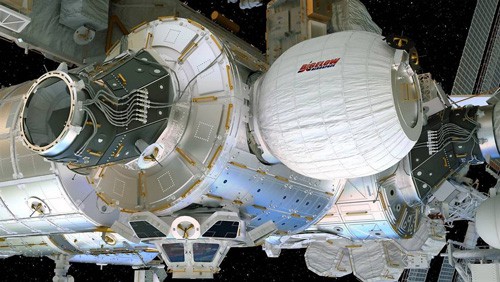
A few minutes after it reached Full Shape, Williams set to work with Mission Control to pressurize BEAM’s interior, using eight tanks stored aboard the new module. Pressurization began at 4:34 p.m. EDT and was concluded about 10 minutes later. This set in motion another series of extensive tests, which will include an 80-hour sequence of leak checks, prior to the first opening of BEAM’s hatch and ingress by the Expedition 47 crew.
These leak checks got underway from Mission Control on Saturday evening, overseen by the Operations Support Officer (OSO), the Environmental and Thermal Operating Systems (ETHOS) Officer and the Integration Systems Engineer (ISE). The OSO console is responsible for logistical support functions pertaining to on-orbit maintenance, as well mechanical systems, including the installation and activation of new modules. ETHOS—which had already played a significant role in the expansion of BEAM via the Pressure Curve Plots—carries responsibilities over the station’s Environmental Control and Life Support System (ECLSS) and internal Thermal Control Systems (TCS), whilst ISE has been described as “a specialist liaison position” between the ISS and its unpiloted visiting vehicles, including the SpaceX Dragon, the Orbital ATK Cygnus, and Japan’s H-II Transfer Vehicle (HTV).
According to NASA’s Rob Navias, the first ingress of BEAM has moved from Thursday, 2 June, to Monday, 6 June, although this date remains Under Review. “Williams goes in first for an air sample,” Mr. Navias told AmericaSpace, “followed by a Russian [cosmonaut] for an air sample.” The identity of the Russian cosmonaut remains To Be Determined. The ingress of BEAM is expected to see Brian Smith at the Flight Director’s console and Jessica Meir reprising her role as Capcom.
During the initial ingress, Williams will take an air sample and close BEAM’s hatch for about 20-25 minutes, allowing the internal air to “scrub-out.” He will then re-open the hatch to set up a series of modal dynamic sensors inside the module. “The entire ingress,” Mr. Navias told us, “should take less than two hours.” It has been reported that BEAM will subsequently be ingressed “several times” per year, although there is “no timeframe” for when the follow-up ingresses will take place. Mr. Navias also noted that they are expected to be relatively brief affairs. “Just opening the hatch for inspection,” he explained, “and closing it right back up after inspections and a few air samples.”
There are no lights inside BEAM, so when the astronauts ingress, they will carry battery-powered flashlights. At various locations, they will install sensors to monitor temperatures, pressures, radiation conditions, and Micrometeoroid Orbital Debris (MMOD) impacts. These sensors will poll data over the anticipated two-year expanded mission to a laptop aboard Tranquility and from thence to Mission Control for analysis. In her summary, Heide Brewer noted that radiation “patches” would be installed “every couple months,” with air recycling quickly through the module, about once every 39 minutes.
The module is expected to remain attached to the ISS for about two years, whereupon it will be detached from Tranquility’s aft CBM, via Canadarm2, and released. “It moves away from the station on its own due to its mass and ultimately deorbits,” Mr. Navias told AmericaSpace. From the perspective of BEAM’s creator, Bigelow Aerospace—which has already delivered expandable hardware to orbit and has significant future plans in low-Earth orbit and beyond—sees the module as a tool to increase its Technology Readiness Level (TRL). And NASA anticipates a major role for expandable habitats, with possibilities extending to cislunar space and even the surface of the Moon itself. In effect, BEAM will serve as a vanguard for larger and more complex expandable habitats. “The expandable feature of this module is that it takes up less space to get to orbit [and] less mass to get to orbit,” explained Heide Brewer, “so if we’re able to utilize in the same way that we do our traditional aluminum modules, it may be game-changing for future exploration.”
Want to keep up-to-date with all things space? Be sure to “Like” AmericaSpace on Facebook and follow us on Twitter: @AmericaSpace




